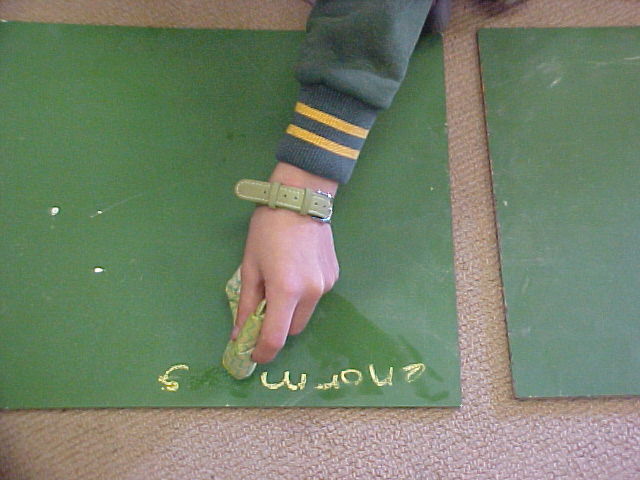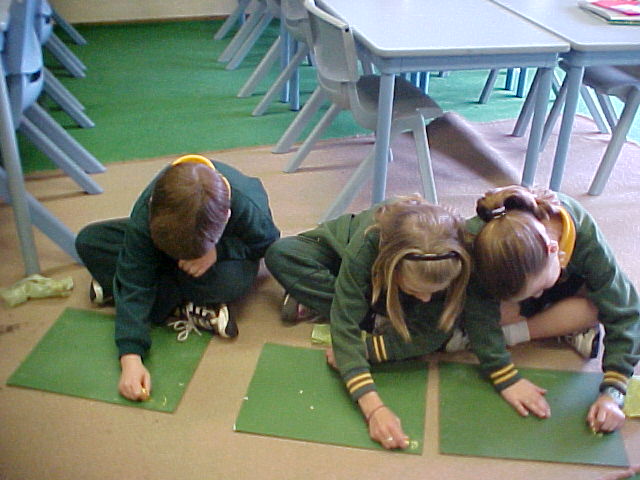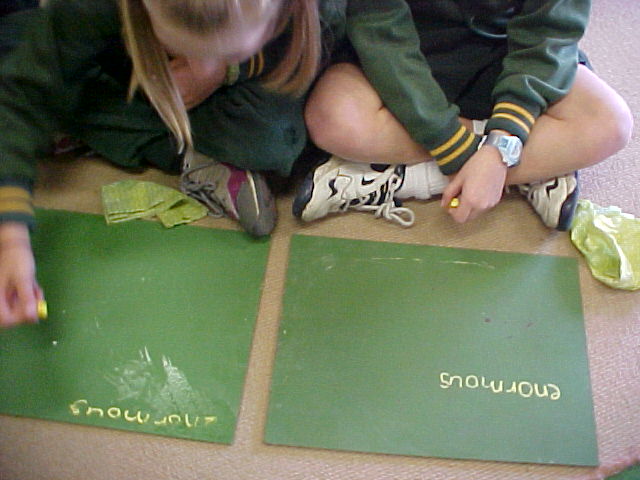Scaffolded Spelling
Introduction
English spelling is a rule system that connects the sounds of words
with their written forms. (Steven Pinker. Words and rules.
1999)
English is an alphabetic language,
but one where sounds can be represented by different letters or combinations
of letters, often depending on the words' origins.
The strength of the English
language is that people can write it correctly world-wide, regardless
of regional pronunciations. English spelling is much better than
people think it is. That is because writing systems do not aim to represent
the actual sounds of talking, which we do not hear, but the abstract
units of language underlying them, which we do hear. (Steven Pinker.
The language instinct. 1994.)
Where spelling fits in the
sequence
Spelling is the part of the scaffolding literacy sequence where most
of the teaching about symbol/sound relationships and about visual patterns
in English words takes place.
This teaching begins in the
high order book orientation, where, as would be expected in scaffolded
learning, the emphasis varies depending on the grade level and the ability
of the children. In early kindergarten the high order book orientation
includes much opportunity to identify first letters, for grade 2 we
indicated the unfamiliar-looking word 'queue', for the upper grades
we might point out the spelling of a word like 'psychology' at this
time.
The teaching continues through
transformations before the focus of the spelling section.
 In
Scaffolding Literacy, symbol/sound relationships and visual patterns
are taught in conjunction with each other.
In
Scaffolding Literacy, symbol/sound relationships and visual patterns
are taught in conjunction with each other.
The words chosen for analysis
are words whose meanings are very well known. This is essential as the
sound of words is so individual to the listener. To ensure this, the
words are chosen from text that children can read fluently and whose
meaning is understood.
Once children are confident
with word analysis in context, we extend into related words that do
not appear in the text. We show how to decode 'mystery' words, using
knowledge from known words.
As many words as possible are
taught before children are asked to write, so that children are not
asked to 'invent' without sufficient resources to do so in a productive
way.
Children are asked to match
the visual patterns in the word to the sounds they make when speaking
the word - note that this allows for different pronunciations and for
the implications of Pinker's comment above - children do not have to
speak a word 'correctly' to match sound with symbol.
Note that children with 'poor'
auditory analysis learn to spell when they are very familiar with the
meaning of words are taught how to look at words.
'Visual
patterns in English words are many and complex. It takes time, curiosity
and much exploration for a child to master these patterns. This involves
a high degree of risk taking and therefore of confidence.' Scaffolding
Transitional Spellers (Schools and Community Centre 1998)
Scaffolding Literacy provides
a context where it is safe to take risks.

How
we teach
1. Words are chosen from the text we are studying.
2. Transformations provide word cards. The teacher checks that children
can recognise the words out of context. S/he plays games to assist this.
3. The teacher chunks the words into letter patterns. How to decide
on the chunks appears later.
a. She makes sure that the text from which the word is taken is visible
b. She makes two copies of the word on card, one remains intact as a
reference point
c. She cuts the second copy into the identified chunks
d. Children say what sound they match to each letter pattern
e. Games are played with the chunks to encourage looking - eg teacher
turns over one chunk and challenges children to say what letters have
been turned over
f. Children might write single chunks on their chalkboards as described
for whole words in #7.

4. The children practise writing the words. This practice is done as
a whole class, on individual chalkboards. Each child has a moist (prevents
flying chalk dust) sponge and can erase errors instantly (safe). The
teacher asks children to check their spelling as she revisits the word
one chunk at a time on her own board - that is, no-one but the child
(and of course the teacher unbeknownst to the child) knows that the
child has made an error (safe.) Children quietly correct their errors
and identify the part in the word that is tricky for them. Children
practise each word several times.
5. Look, cover, write and say,
check. This encourages remembering what words look like and checking
in chunks, rather than rattling off single letters.
6. The words are practised
in context in Easy Spelling. Easy
Spelling is described here.
7. Charts of studied letter
patterns are begun and displayed in the classroom. These are added to
as the same letter patterns are found in other words. These lists of
very familiar words are used later for extended word study.
-
We find that we run
out of wall space for these charts, and it is important to have
them readily available. Two suggestions are:-
1. Join cardboard charts together in alphabetical order by the
first letter of the letter pattern. This makes it easy for children
to add new words, but it gets unweildy.
2. Keep paper charts in A3 plastic sleeves in A3 folders. This
is easy to use, but is more difficult for children to add new
words.
8. Charts of studied words
are regularly revisited so that children keep improving their automatic
spelling and decoding ability.
How to decide on chunks
(letter patterns) in words
These considerations are based on Scaffolding Transitional Spellers.
Schools and Community Centre. 1998. p. 19, using words from The 27th
annual African hippopotamus race, chapter 6.
Consider:
|
Compound words
|
any thing |
|
Syllables
|
hipp o pot a mus
swagg er ing (Note that the suffix
is determining the last syllable, not the sound, which might
lead you to swagg e ring. Note also
that both the letter pattern 'er' and the function of the second
'g' determine where you break the first syllable.)
|
|
Base word and prefixes
and suffixes
|
whisper ed
go ing
announce d |
|
Changed base word
for suffixes
|
travel l ing
big g est |
|
Onset/rhyme
(identified by cutting
the core word before the first vowel)
|
br ight
sh out ed
j oin
|
|
You can cut after
the vowel unit
|
sh ou t ed
squ ea l |
|
Note that onset/rhyme
and vowel units lead you to the kind of decisions you get on commercially
available charts of letter patterns. In Scaffolding Literacy we
make our own charts, so that children are scaffolded into understanding
what they mean.
|